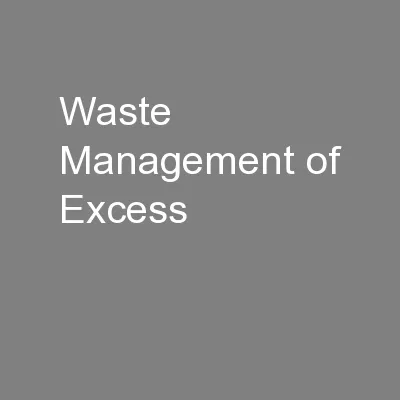

tOPV Selecting Methods for the Destruction of Trivalent Oral Polio Vaccine tOPV during the switch February 2016 1 What is covered in this presentation At the end of this presentation decision makers will be able to select the ID: 484621
Download Presentation The PPT/PDF document "Waste Management of Excess" is the property of its rightful owner. Permission is granted to download and print the materials on this web site for personal, non-commercial use only, and to display it on your personal computer provided you do not modify the materials and that you retain all copyright notices contained in the materials. By downloading content from our website, you accept the terms of this agreement.
Slide1
Waste Management of Excess tOPV
Selecting Methods for the Destruction of Trivalent Oral Polio Vaccine (tOPV) during the switch
February 2016
1Slide2
What is covered in this presentation?
At the end of
this
presentation, decision makers will be able to select the most appropriate methods to safely destroy tOPV after reviewing:
Inactivation
of
tOPV
3
Disposal of inactivated
tOPV
4
Volume of
tOPV
to be destroyed
1
Material of vials to be destroyed
2
2Slide3
tOPV destruction involves inactivation and disposal
Disposal of tOPV after the switch should follow national legislation. If national legislation does not exist, then this presentation provides guidance on how to safely dispose of tOPVtOPV
MUST be inactivated* prior to disposalInactivate by: autoclaving, boiling, chemical inactivation,
encapsulation or incineration
Dispose by: transporting to waste facility or burying
* Inactivation of tOPV is defined as eliminating the infectious nature of poliovirus in
tOPV
or otherwise rendering the
tOPV
vials unusable and inaccessible (encapsulation)
3Slide4
tOPV Inactivation Decision Tree
4Slide5
STEP 1: Evaluate volumes of tOPV vials to be destroyed
5Slide6
STEP 2: Determine materials of tOPV vials to be destroyed
6Slide7
STEP
3: Choose appropriate method to inactivate tOPV
Autoclaving
Boiling
Chemical inactivation (e.g. with bleach)
Encapsulation
Incineration
7Slide8
Ideal use and drawbacks of tOPV inactivation methods
Autoclaving
Boiling
Chemical Inactivation
Encapsulation
Incineration
Ideal
use
Autoclaving
should be done
in a large autoclave with integrated shredder.
Alternatively, vials can be opened and treated in any autoclave.
Boil unopen
ed vials
Chemically inactivate opened vials using bleach or other chlorine solution
at the recommended concentrations (0.5%).
Encapsulate unopened vials in containers filled with concrete.
Incinerate in a high-temperature incinerator capable of safely handling glass (such as a rotary kiln incinerator).
Drawback
Unopened/unshredded vials may not be fully inactivated in an autoclave, especially if the autoclave has been densely packed with other waste that could act as an insulator.Closed glass vials may explode under pressure if unopened.
Boiling may be impractical
for treating large quantities of vials.
Operators must be careful to avoid scalding
Expensive for processing large quantities
of vials and requires operators to be trained in using chlorine solution.
Chlorine solution must be safely disposed of
Concrete-filled containers must still be securely buried.
Melted glass can damage incinerators at
temperatures
<
1100°.
Closed glass vials can
explode under pressure if unopened
Plastic vial incineration is prohibited in many countries due to toxic emissions.
Please note:
Staff should handle open vials as hazardous infectious waste and take precautions (e.g. wearing personal protective equipment)
8Slide9
Autoclaving
High-temperature steamMost environmentally friendly methodGlass vials full of liquid (i.e. not opened) should be “loosened” to avoid rupture, unless the autoclave has an integrated shredder
Plastic vials or glass vials that contain little liquid do not need to be open or punctured After autoclaving, vials will be sterile but must still be disposed of following national or local waste management guidelines for municipal waste
9Slide10
Boiling
Immersing vials in boiling water for approximately 30 minutes destroys pathogenic micro-organisms*Both glass and plastic vials can be safely boiledGlass vials can be boiled without opening
After boiling, the inactivated vials should be disposed of following national or local waste management guidelines
*http://www.cdc.gov/hicpac/pdf/guidelines/disinfection_nov_2008.pdf
10Slide11
Chemical Inactivation
Inactivate tOPV using 0.5% chlorine solutiontOPV
vials should be opened and immersed in the solution for at least 30 minutes9 parts clear water to 1 part household bleach
20 vials can be safely sterilized in 4 liters of solutionAfter treatment, vials and leftover chlorine solution must both be disposed of following national or local waste management guidelines
Koshmanova
T:
Stomatologia
(
Mosk
) 1998;77(1): 48-0
http://
www.biosafety.be/Polio/www729.pdfhttp://www.cdc.gov/hicpac/pdf/guidelines/disinfection_nov_2008.pdf11Slide12
Incineration
Open
pit burning of plastics can have a severe negative environmental impact
should not be used as an inactivation
method
Incinerators vary in temperatures reached in primary waste
chamber
Low temperature burning (
<800°
C) is
not recommended
because it is environmentally hazardous (e.g. single chamber cement or brick covered incinerators)Medium temperature burning (800-1100°C) using dual-chamber incinerators may cause glass vials to explode or partially melt, and it is not recommendedPlastic vial incineration may be prohibited in some countries due to toxic emissions but is possible at medium and higher temperatures (>800°C) if permitted by national emissions guidelines
12Slide13
13
Incineration, cont.
>
1100°C is needed for safe destruction of glass vials with
tOPV
(e.g. rotary-kiln incinerators and industrial furnaces
)
Co-incineration
in industrial furnaces (e.g. cement kilns) will both inactivate and destroy
tOPV
vials and can be done in partnership with an industrial facility
Ash and any other post-incineration residue must be treated as toxic waste and disposed of according to national or local waste management guidelinesSlide14
Encapsulation
Disposes of
tOPV without immediate inactivation (and without opening the vials) but makes it inaccessible and puts it beyond useInvolves filling containers
¾ full with tOPV vials, adding an immobilizing material
(e.g. sand, cement, or clay) and sealing
and burying the containers
Encapsulated waste
must be disposed of following National or local waste management guidelines for municipal
waste
14Slide15
STEP 4: Dispose of the inactivated
tOPV vials
Transport the waste materials to a waste facility (e.g. sanitary land fill, municipal dump, industrial waste site, or other facility meeting national and local waste guidelines)
Bury the waste materials on-site in a secured and fenced-off burial site
15Slide16
Thank you!
16